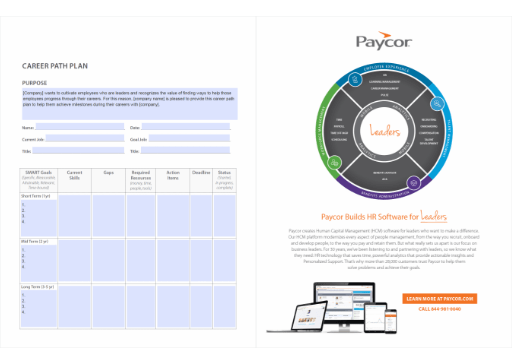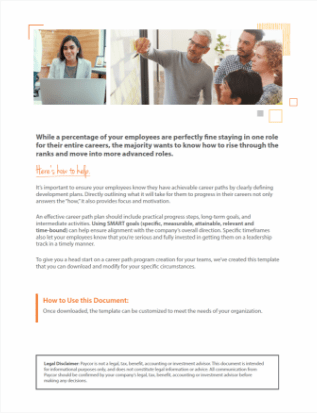Your employees want to move up in the world
Employees at companies with internal mobility stay almost 2x longer (LinkedInLearning).
If your employees don’t see a well-defined path from the jobs they have to the jobs they want, you can help.
Directly outlining what it will take for your employees to progress in their careers not only answers the “how,” it also provides renewed focus and motivation to stick around.
What should a career path plan include?
A career path plan should include progress steps, long-term goals, and intermediate activities. Use SMART goals (specific, measurable, attainable, relevant and time-bound) to help ensure the goals you’re setting align with company direction. Specific timeframes also let your employees know that you’re fully invested in getting them on a fast-track to leadership. Include existing skills that support the new role as well as skills that are lacking to help set concrete guidance for the proficiencies the employee needs.
Should external training be included in a career path plan?
While some action items may be completed by internal learning and development programs, some activities, such as external trainings or new software programs, might require an intial financial investment. Keep track of these items so everyone is on the same page and there are no budgeting surprises come year-end.
Can career development path plans change?
They absolutely can! An important thing to remember is to make sure the plan isn’t so rigid that it can’t be changed if circumstances do. As your employees grow in their careers, their ambitions and passions will likely change, too, so it’s essential to have the flexibility to make modifications.
Career development planning should be a continuous process, not a fixed, “set it and forget it” event. Further conversations and re-reassessments should always be on the table to give your employees positive career opportunities for growth.
How Paycor helps
If you’re looking for an easy way to plan your company’s future overall success, Paycor’s Career Management software eliminates the complexity of succession planning by enabling you to collect data about internal leadership candidates. When you have that information at hand, you can better execute big-picture strategies that drive engagement and focus on business outcomes. With Career Management, your employees get feedback specific to their development plans and leaders can future-proof their workforce.











